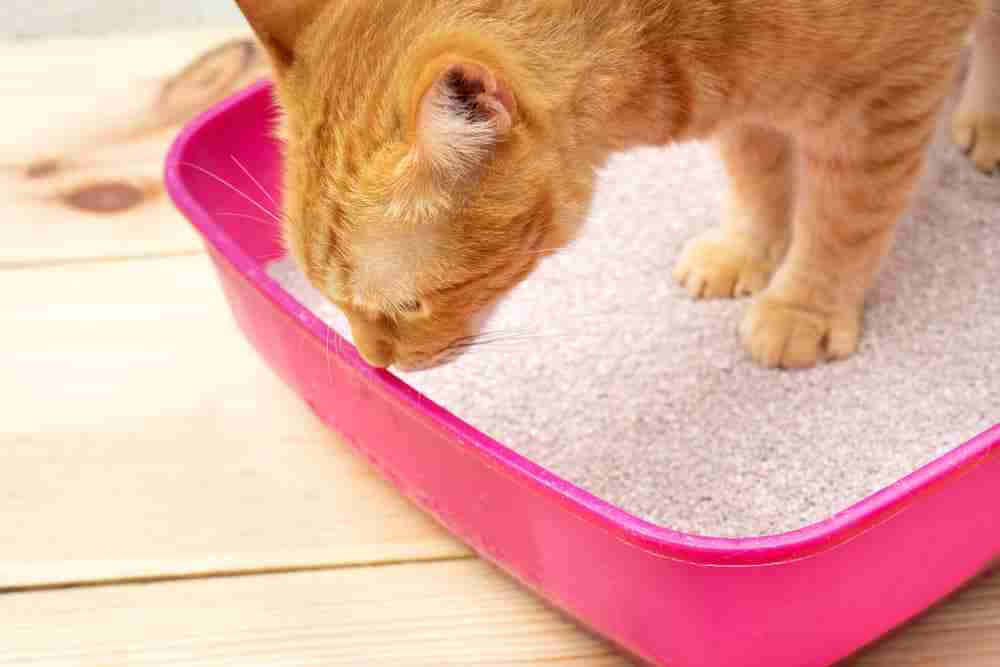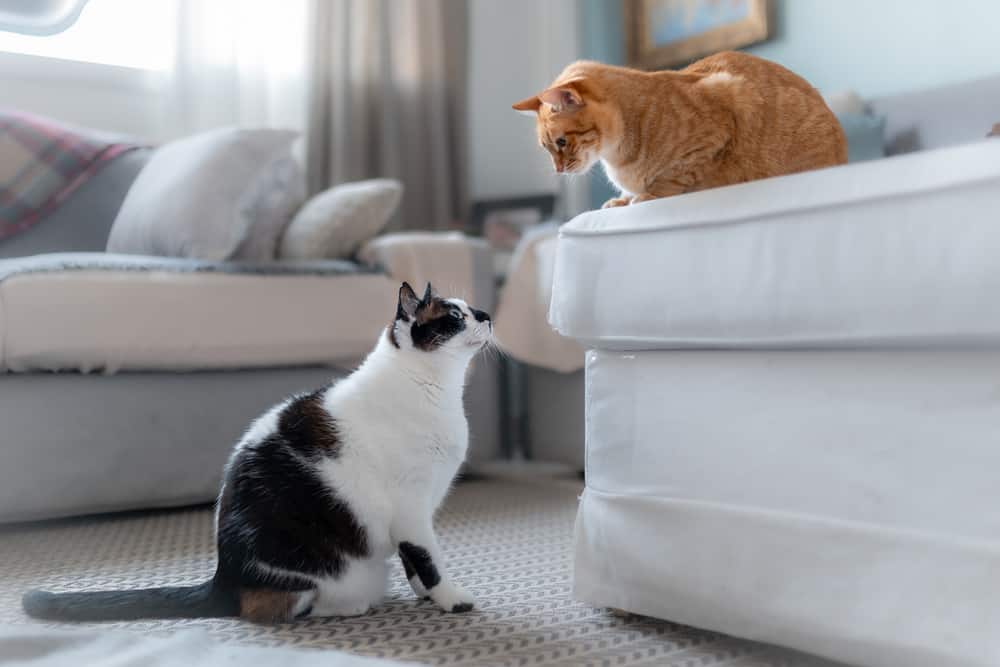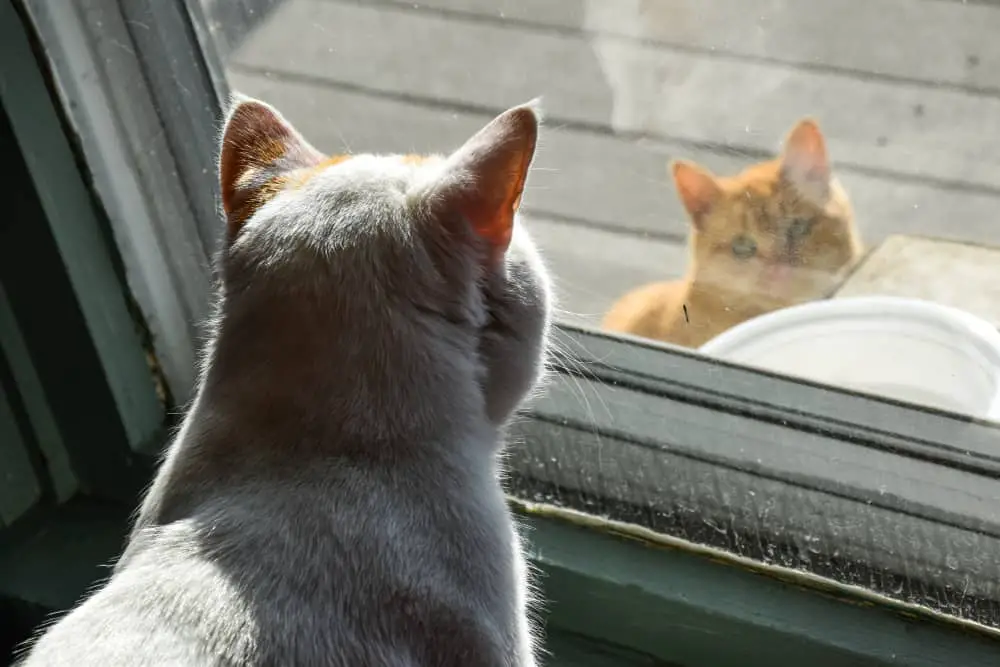Do you need to know how to stop a cat from spraying in the house? The simple solutions to this problem include resolving medical issues with the cat, neutering or spaying if not completed already, de-stressing your cat, and using more litter trays.
We go into more depth and provide tactics for you to end this problem behavior. Read on to learn more…
What Is Spraying
Spraying or marking around the home is broadly speaking inappropriate urination by your cat. Basically, when a cat sprays they stand upright, back up to an object, and sprays a fine mist of urine onto an object. This differs from when they urinate. When a cat urinates they usually crouch and empty its bladder.
A cat peeing outside the litter tray in close vicinity to the tray is not necessarily spraying but maybe urinating due to a problem with the tray. A cat peeing against a wall or a piece of furniture is spraying to mark. A cat urinating some ways off from the litter tray may be marking or may have been caught short due to age or illness – these are factors that will require detective work from the homeowner!

Why Do Cats Spray?
Spraying or marking is a completely natural behavior for a cat. It is instinctual like hunting. Spraying is one of several methods of communication that cats use along with body language and vocalizations.
Cats have an extraordinary sense of smell. This makes spraying a great communication tool. They can tell from spraying who has been in the area, their reproductive status, health, daily or weekly routine, and social status of other cats.
It is a messaging system for cats. They can spray updates and other cats can return the message. Being territorial animals, cats use spraying and other scent messages to convey territorial rights and ownership of objects in the environment.
Why Do Cats Spray Indoors?
You might be thinking that spraying in nature is fine but within my home, there are no other cats to communicate with so why is my cat spraying my couch? Cats can end up spraying in the home for a number of issues. These are the most common reasons a cat sprays in the home:
Stress
Cats are creatures of routine and even minor changes to their environment or routine can stress them out.
Changed your shift pattern, moved the furniture or redecorated, got new neighbors, new animals showed up in the neighborhood, any minor change to the environment can trigger stress in your cat.
Your cat may respond to stress by trying to re-establish a sense of belonging or territorial ownership by spraying.

Medical Issues
Your cat may be spraying indoors because they have developed a medical issue that is giving them a problem.
A UTI, kidney issue, or bladder stone issue may increase stress on your cat or simply lead to them marking or urinating inappropriately as they are caught short.
Conditions such as hypothyroidism and diabetes can lead to your cat urinating more frequently and in greater volume. If your cat is not expecting to need to pee it may be taken by surprise.

New Pets or Householders
Getting a new cat, dog, baby or partner can all trigger episodes of spraying. Your cat may feel the need to strengthen its territorial rights by spraying and marking as new occupants come into the home and are perceived to encroach on your cat’s territory.
Not Neutered
If your cat is not neutered or spayed they are far more likely to spray and mark.
They will be more territorial and will be looking to signal their reproductive status on a regular basis to any cats in the near vicinity.
This is natural behavior and won’t switch off or reduce just because the cat lives indoors and has a pampered lifestyle!
How To Stop Cats From Spraying In The House?
So, given we know why cats spray, how can we stop them from spraying indoors? These are our top tips to reduce spraying in your home :
Medical Check-Up
First up, no matter the age of your cat, get them checked over for any medical issues. Cats can hide problems really well. Your vet may be able to examine your cat and identify a medical issue that could be creating the problem and treat the issue.
On the other hand, they may confirm your cat is ok and rule out a medical issue so at least you know your cat doesn’t have a problem.
Neutering Or Spaying
If your cat is not neutered or spayed you are really going to have a hard time stopping them from marking. The urge is strong in unaltered cats.
They are spraying to convey fertility and reproductive health and they are marking territory to convey that the sexual activity in that area is going to be their and their alone!
If your cat is not altered and you want to fix a spraying problem then most of the problem can be resolved by the snip!

Reduce Stress
Really you need to identify the source of the stress and eliminate the stress or acclimatize your cat to the stressor.
If you have a new cat in the home or a new pet it is best to introduce cats in a proper way, incrementally until they are used to each other and familiar. See our guide here.
If you have a new child or partner in the home it may be best to reduce the cat’s range by keeping it out of some rooms and providing it with a scented piece of the baby/person’s clothing.
If you provide the cat with treats whilst they are near this scented clothing then they should relax around the new scent and associate the new scent with treats and good experiences.
If you have bought new furniture for the home or re-decorated it and are getting an adverse reaction from the cat then it can be a good idea to transfer some of the cat’s scent to the area.
You can use some of the cat’s bedding or wipe cloth on the cat’s face and then rub it on new furniture or decorated walls to transfer your cat’s scent to the object causing the stress.
Hopefully, the cat will associate the new object with their own scent and decide that marking is unnecessary.
A simple cat pheromone plug-in may be enough to calm your cat and reduce marking if they have been stressed by changes to routine.
More litter trays
Placing litter trays at areas that are getting marked probably won’t stop the activity in the area but should result in the cat using the litter stray at the spot rather than marking. This can be a good technique to reduce hassle until you can eliminate the cause of the spraying problem.
Additionally, extra litter trays particularly if you have numerous cats or cats that are getting caught short or you suspect you might have a picky litter tray user may resolve the problem.
In a multi-cat household where cats are deciding territory, additional litter trays can reduce pressure on the territory to be shared and reduce possessive marking.
You might have a cat that has had a bad experience with the tray or be unhappy with the cleanliness of the tray and is inappropriately urinating as a sign of displeasure. Multiple trays can reduce these issues.

Reduce Visibility To Outdoors Or Solve An Outdoor Issue
Think about where your cat is spraying. Are they spraying on or near a perimeter?
If they are spraying in doorways, under windows, or against windows they could have spotted a cat outdoors and be marking territory against such cats.
In these instances, you should place a litter tray at the perimeter areas your cat is spraying in and so they use these litter boxes so you don’t have to clean up and then focus your attention on keeping other cats away from your home or stopping stray cats from spraying outside your home.
If you can push back the local cat population so your cat doesn’t feel surrounded, your cat will stop marking territory indoors.
Some basic tactics can include spreading your cat’s used litter to the yard perimeter to reclaim the area for your cat to using motion detector water sprays and chemical sprays to ward off intruder cats.

Use A Deterrent Spray
If all else fails or if you want to go all-in you can use a cat deterrent spray on your furniture, walls, or at critical spots. Your mileage will vary but we outline how to make a homemade cat deterrent spray here and you can buy commercial versions online.
The thing with deterrent sprays is that they take a build-up of the spray to work and then need levels maintained going forward so whilst they can be a useful tactic they may be a very labor-intensive way of resolving this issue!
Final Thoughts
Stopping a cat spraying around the house requires a little detective work to identify the cause so you can formulate an effective response. In most cases, once you understand the cause you can quickly change the cat’s behavior and get your home back to normal. Hopefully, some of our tactics will work for you!
